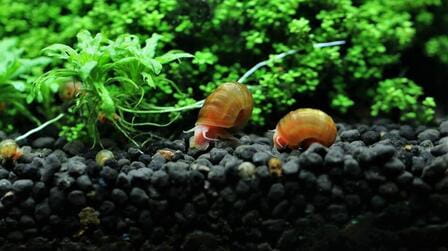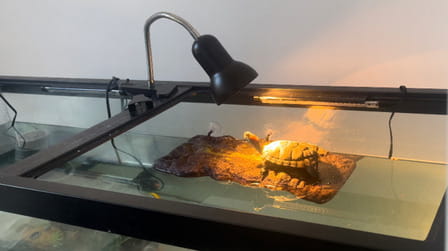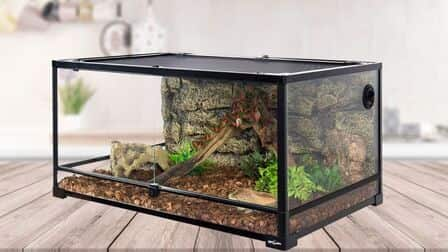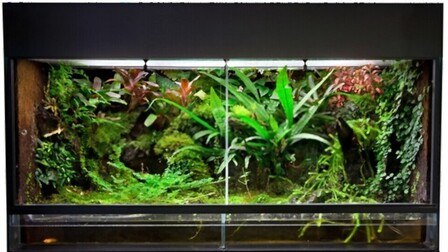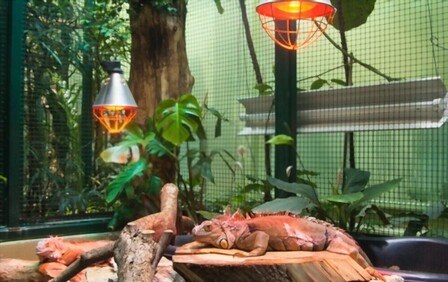In the article on how to set up a reptile heat lamp, we will describe more clearly how to choose and target to install in the best reptile habitat. In addition, we strive to make an in-depth and comprehensive guide to the different types of heating and lighting products available in the pet market. Proper planning will produce a happy and healthy reptile and will lead to a few health problems.
1. Objective to install how to set up the reptile heat lamp
There are many options available to provide reptiles with the right lighting and heating needs. A system that is both suitable for the needs of the animal and in the pocket of the owner.
Light is important because it helps regulate your pet's sleep cycles and mating habits and helps maintain the animal's health.
Heat is very important as it helps maintain the reptile's body temperature and aids digestion.
However, before you buy a pet, read about the specific needs of the animal, as they are all different.
Often exotic reptiles and amphibians come from all over the world and recreating the environment is important and sometimes challenging.
2. Measuring gadgets
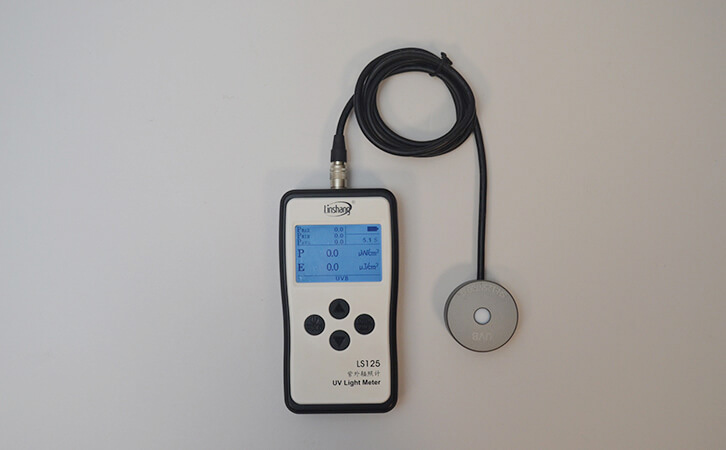
Reducing certain variables will help eliminate a lot of guesswork when setting up pet shelters.
Investing in a simple lamp timer is an easy and inexpensive way to automate the on/off cycle of various appliances.
Otherwise, you can buy it from a hardware store, pet store, or online. For most simple setups, hardware storage timers are cheap. They are used to turn appliances on and off at certain times of the day or night, like lights or holiday decorations. With these, also determine the time to turn on and off the lights and heat during the day. It's a lot simpler than remembering to turn the switch on and off every day. Plus, some exotic species rely heavily on having a proper light/dark cycle, and a timer is an easy solution.
Thermometers help to check the proper temperature in different areas of the reptile's enclosure. Since reptiles are cold-blooded and must regulate their body temperature, a warmer and cooler area in the enclosure (also known as a "thermal gradient") is essential. Thanks to the special function, you know how to quickly look at an area of the cage, be able to decide if the temperature is enough, and make changes if necessary.
3. Plan to set up a heat lamp

Consider the reptile and enclosure dimensions before installation. What needs to be done is to plan how the enclosure will be lit and heated.
Most simple setups for small reptiles usually include an incandescent light bulb on the lid of the aquarium. Other times, lamps and heat sinks are used. This is enough for most beginner reptiles (Anoles, bearded dragons, corn snakes)
As for larger animals (monitor lizards, boas, pythons), animals with long lifespans (turtles, lizards, snakes), or animals with very specialized habitat needs (frogs).
Additionally, you consider the habitat needs and lifespan of the animal and compare prices.
4. Energy demand
Usually, the lights will charge per kilowatt hour (kWh) used. Calculating how much energy to use per day, month and year are useful when comparing options.
You can use these simple equation:
a (b / 1000) x c = d
a = the number of devices with the same wattage to use (such as two light bulbs)
b = capacity of devices
c = number of hours per day the device will operate
d = kilowatt-hours per day consumed to power the setup.
We calculate the wattage of a setup using two incandescent bulbs and a heatsink. Daylight bulbs and night lights like the two bulbs both have 60 watts of power and each has a 12-hour on / 12-hour off cycle. Therefore, we take the wattage of the bulb (b) and divide it by 1000 (which would be 60 divided by 1000) and get 0.06. Since there are two in setup (a), we multiply that number by two (2 x 0.06 = 0.12). Take that number and multiply it by the number of hours they work each day (c) (0.12 x 12 hours = 1.44). The final figure is the kilowatt-hour the device uses per day. In this case, it is 1.44kWh/day and the equation will be:
2 (60/1000) x 12 = 1.44
The heat projection panels are 15 watts and turn on for 14 hours a day. The equation will be:
1 (15/1000) x 14 = 0.21 kWh/day.
5. Rheostats and thermostats


Voltage stabilizers and thermostats are useful equipment to use for reptile cages. They can help regulate and fine-tune the amount of light and heat in an enclosure.
The thermostats and thermostats are a little different. While the thermostat can be used to turn the heater on and off when the cage reaches the appropriate temperature, the thermostat can act as a dimmer, thereby increasing or decreasing the amount of heat. Electricity goes to a certain device such as a lamp or appliance heater.
Thermostats are convenient because they won't allow the enclosure to exceed a certain temperature wherever the sensor is located. The thermostat is set to a certain optimal temperature, the sensor is placed somewhere inside the reptile enclosure, and it will cause the heater to turn on or off to maintain the proper temperature. As they do not require large thermal gradients sunbathing but need to maintain the overall temperature.
Also, you don't want to use a thermostat when controlling a device such as a light as it will cause the reptile's natural day/night cycle.
A good device to use where the animal is going to touch, lie under, or lie on top of a heater is a rheometer. The controller can be screwed up or down like a typical household dimmer switch to adjust the amount of power delivered to a particular appliance. Mostly, the heater itself maintains the proper temperature. Once it is adjusted properly, the heater will not be able to overheat and burn a reptile. Simply use a thermometer to measure the temperature of the device and rotate the rheometer up or down until the device maintains the proper temperature for the reptile's needs.
On the other hand, a thermostat can also be used for some lamps to increase or decrease both temperature and light output.
You can use them to control two identical lamps or two identical heaters, but do not use a rheological regulator to control lamps and heaters.
6. Lighting
There are many types of lights on the market today, keep in mind how often you will need to replace them. Fluorescent lamps have a longer lifespan resulting in less long-term use costs than incandescent lamps but do not generate heat. Fiber burns faster, but also provides heat. Using the equation in step 4 will help with the amount of power that will be used.
If lighting must be inside a reptile enclosure, consider fluorescent lights as incandescent lights can burn the animal if touched (like an iguana or snake). If the light is up and down, then an incandescent will work because there is no danger of an animal touching it.
Reptiles use light to strengthen their bones and regulate their metabolism. Specialized reptile lights provide them with the right amount of UV (ultraviolet) light that they can't get from standard bulbs.
7. Daylight shade
Daylight bulbs mimic the sun. This light provides the proper balance between UV light and heat. They come in different sizes and wattages from 15 to 100. They also heat the cage because incandescent lamps generate heat.
These lights are usually placed above the cage in a reflective dome to mimic the sun's rays falling to illuminate and warm the cage.
However, it is quite dangerous to use inside or too close to the enclosure. If a snake or lizard touches a bare bulb or gets too close, it can get burned just like a human when touching a hot bulb. If incandescent bulbs are inside the cage, use a wraparound dome and make sure the animal cannot climb on top of it (heat rises). Invest in a shield made to pass through the open end of the dome enclosure to prevent animals from crawling inside.
Also, if the light is placed too close to the barn, it can become too hot for the reptile. This can be remedied by choosing an appropriate wattage bulb and monitoring the temperature inside the housing. To remedy this situation, move the lamp further away or purchase a lower-wattage bulb, as the high heat will ripen the animal. Since the rheometer acts as a dimmer, it can reduce the amount of light and heat. However, the standard bulb on the dimmer switch can make it more likely to burn out faster.
Usually, a good cycle for these lights would be around 12 hours on / 12 hours off per day. However, some reptiles may require more or less light. To more accurately reproduce the home climate, study the place of origin of the species and the climate there.
If pets are nocturnal, it is still important to re-establish the proper daytime light/heat cycle.
8. Basket lights
Lights work the same way daylighting lights work. They are specialized to provide the right amount of UV light, but spotlights are used mainly when trying to recreate a hot or desert-style environment.
Animals such as tortoises, iguanas, monitor lizards, bearded dragons, and certain snakes benefit from the light because it reproduces solar activity in a desert-type environment or tropical.
Lights are often used in conjunction with daylight bulbs. Daylight bulbs are there to provide overall lighting of the cage while spotlights are used to heat a specific part of the cage such as a rock or a piece of wood.
In addition, luminaires are also often controlled by a rheometer because the purpose of the light bulb concentrates a large part of the heat on a small surface, recreating an area that the animal would use to bathe in nature. This helps regulate the amount of heat the light produces, making the animal less likely to get burned. If the bulb must be in a reptile enclosure, make sure animals cannot climb on or touch the bulb, as the light is very hot. If using a reflective dome fixture, consider purchasing a display that fits over the open end of the fixture.
If the reptile is nocturnal, this light is probably not necessary as the animal will most likely be hiding or resting during the day and not exposing itself. It is important here to re-establish the appropriate light/heat cycles for the animal, as the absence of these cycles is what triggers the animals' nocturnal activities.
9. Infrared light
Night bulbs are used to provide hot or desert climate reptiles with the temperature they need during the night.
These lights are red. They give off the heat that reptiles need during the night while also producing infrared light that is invisible to the reptiles, thus allowing observation of the animal's natural nocturnal habits.
When the lamps are used in conjunction with daylighting bulbs and/or daylighting bulb setups, a lower wattage than comparable daylight lamps may be possible. Since there are no light and cold nighttime temperatures, some factors stimulate nocturnal reptiles to become active at night, so the cage will not need to be as hot as during the day. You also need to control the night light with a rheometer that will help maintain the right temperature throughout the night while allowing the lights to be observed.
The red light is merely to please nocturnal reptile owners by being able to take a closer look at the reptile's habits.
If the animal is nocturnal but does not need much or any heat at night, halogen and fluorescent equivalents are available.
However, these lights should be set to come on when the daylight bulbs are off, or they can cause the enclosure to become uncomfortably hot.
Given the energy and cost, using halogen or fluorescent bulbs in combination with heating equipment can prove to be more efficient than an incandescent setting.
10. Moonlight
Moonlights are another specialized type of night light. It helps to simulate the natural light of the moon, allowing nocturnal reptiles to carry out their nocturnal activities.
Other nocturnal animals may need moonlight to see but not heat. In this case, a fluorescent moon lamp or equivalent LED will work.
It is advisable to choose the lowest wattage bulb needed to provide the right amount of heat and light and fine-tune it with a rheometer. Always make sure to prevent animals from touching it.
11. Heating
Reptiles are cold-blooded, they need heat to help regulate their metabolism and to gain energy. The natural rise or fall of heat can trigger feelings of hunger, mating habits, successful births, and the start or end of a sleep cycle. Reptiles depend on the heat for most of their life, which is why it is so important to provide them with the right amount of heat.
But you also need to monitor the temperature carefully, as most heaters have the potential to burn a reptile if not used correctly. Decide if you need a thermostat, a rheometer, or both, and buy them as many of these devices are designed for use.
12. Aquatic heating machine
Aquarium heaters come in many shapes and sizes, are typically built to be submerged in water up to a certain amount of gallons, and have a built-in thermostat that will turn them on and off to maintain optimal water temperature, often for frogs, newts, and turtles.
Make sure that placing heaters in the housing will not result in burns, as they can become very hot - even underwater.
Most often heaters like this have a built-in thermostat or other temperature control system, if not, they must be controlled with an additional thermostat. The purpose of these devices is to maintain the overall temperature of the water in the aquatic system, it is advisable to control them with a thermostat.
13. Mats and hear pads
Heat mats or heat pads are among the most commonly used products to increase heat in an enclosed area. They usually stick to the bottom of the glass aquarium and transfer heat from the bottom up by warming the glass.
Heat mats come in a variety of sizes to fit almost any aquarium setup. Like any other heating device, they can become too hot for reptiles, which makes them well-suited to rheological systems. They can then be set to maintain the proper temperature.
However, instructions and precautions should be followed to install a product in the setup. In general, heat mats cannot place aquariums directly on top of them, and some manufacturers include small rubber feet that stick to the bottom of the aquarium. And heat mats aren't made for use in reptile enclosures either.
Heat mats typically last a long time and use a small amount of energy.
14. Radiant fan
Radiant heat mats work in a similar way to heat mats. And it's well-suited to be used inside reptile enclosures. They can be controlled with a thermostat to help maintain the overall temperature of the enclosure or with a rheometer to provide hot-climate reptiles with an area to bask in the sun.
Some radiant heat panels may already have a built-in thermostat or rheometer, you should control the temperature with the appropriate equipment. As with any other heater, check and make sure that the area or control panel is not too hot to burn animals or create unhealthy levels of heat.
Conclusion
We have provided some information needed on how to set up a reptile heat lamp. Remember, proper heating is one of the most important aspects of successful reptile farming. By consistently providing reptiles with the right temperature range for their species, it also provides an important piece of the puzzle needed to create a healthy and comfortable environment for pets.

